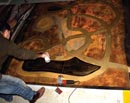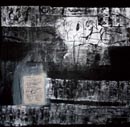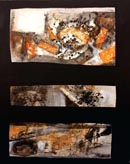If there’s an esthetic expression that arouses amazement and suspicions virtually all around the planet, coupled with digressions, surprises and imitations –especially in the field of arts– that’s abstraction. What started up a hundred years ago in the exquisite, cold and complicated cultural environments of the Russian empire, eventually split the visual world in two sides that now coexist without major ideological complications after overcoming the initial scare that only a handful of experts warned about at the time: figuration and non-figuration.
Few expressions generated such a colossal rift in the history of art when everything or nearly everything was thought to be a pure representation of things, like painting things rather than emotions, feelings, ideas or concepts. Now seen from a view very much in sync with the times of revelations and rediscoveries we’re living in, abstraction is some sort of proto-history of conceptual art, that equally important movement that also transformed –under other peculiar theoretical principles– the going of the contemporary art. But just like conceptual art easily shows some clear-cut intellectual strongholds and players, abstraction, for its part, is still standing on blurry, thick grounds where poetry, unconsciousness, spirits, mathematics and physics, all armed with their own myths and legends, with their intertwined basics and appearances so hard to pry open without the help of powerful knowledge and acute intuition, pop up before our very eyes.
However, its practice wallows in evident secularity. In the most remote African towns and villages, artists splurge themselves into abstraction with awesome easygoingness and naivety. The same happens in the tangled-up sandy surfaces of the Arab world, yet with more awareness and in compliance with the foundations of their religion. And that same view applies to the extraordinary abstract wealth of Latin America and North America, so common place all along the 20th century and even the one that came into being long before the clash between Europeans and the lavish environment and culture that reigned in this region in the late 15th century.
Like any other expression with a history of its own, with bigots and detractors, it doesn’t resemble its former self. It has endured countless mutations, beneficial influences, alterations. Some people even talk about “abstract” schools in countries and, to top it all off, in certain cities. Its many variants –geometric, lyric, informal, constructive– came up to us back in the 1950s, lifted by that mythical group known as The Eleven that showed us the door to look out at what was going on in Europe and later on in the U.S. in the field of abstraction. For some people here in Cuba, the peek outside that door was shocking, unfit to a visual art so much fascinated by local landscaping and colors and by the quest for the “national” identity that gave raise to the first and then the second avant-garde wave organically emerged and egged on from outside to evolve, sooner or later, into what was later known as the “School of Havana.”
Many were surprised to hear the school was in tune with our social and political situation and it gave rise to doubts that were fortunately cleared up with the passing of time for the better of this culture which is, unlike many others in the world, open to everything going on in the planet.
Therefore abstraction in Cuba continues to be a powerful movement revealing unknown traits of the world around us and of our inner self. Cuban painters and sculptors continue to look into new subjects, topics and materials in their determination to bring forth essential aspects of human experience that can be revealed only through observation and contemplation, even though historians, art critics and scholars have rushed to announce the end of the retinal art era, based on too unsound grounds.
To be fair enough, painting has been the expression of abstraction par excellence, beyond its early days, and Rigoberto Mena is very aware of that as he chooses it as his main working tool.
With regular exhibits in galleries, museums and events of different scopes in Cuba and overseas, Mena has become the most powerful analyst of the history of abstraction and of the changes it brings in as he moves from one field to another, no matter if it is architecture, photography, engraving, design or drawing, because he knows no physical or intellectual boundaries when it comes to materializing whatever blooming from the very depths of the exterior or his being.
Being aware of the fact that everything around us has endless abstract components, Mena is constantly taking pictures of building facades, pavements, walls, architectural details, without regarding the preservation state, because nothing is more abstract for him than objective reality itself. He incorporates many of those images into his works and expositions in high-quality pictures; he turns others into ambiguous symbols or subtle metaphors that he later adds to his canvas or cardboard paintings. He takes from reality without any prejudice whatever he finds useful, since reality has become a true challenge to his work; hence his interest in dominating it all the way down to the purest intimacy of the individual act of creation.
I would dare to say that Mena bears a great deal of that outer world, and more specifically of what each of the cities he has been to or lived in means.
He has the great habit of reading lots of books about art and eastern philosophy, visiting exhibits, appreciating the beauty of the world embodied in a random object, in the leaf of a tree, in a woman, which is not insignificant, although it could seem normal or even superficial to some. He is particularly attracted to Leonardo Da Vinci’s hardly exhibited drawings, because of the texts written on them, his unfinished sketches and diagrams, his notes and the oxidation of the pieces of paper the maestro probably left behind at some point of his life. Likewise, Mena loves Panamarenko’s drawings which, thanks to wise editors, are now shown in luxury exhibits as pieces of projects waiting to be materialized; he cherishes the immeasurable flow of visual resonances coming out from intimate graphics by Cy Twombly, Jean Michel Basquiat, Joseph Beuys, Tapies, Brice Marden, although not all of them are considered abstract creators. Sculptors Chillida and Oteiza are also part of the cluster of artists worshipped by Mena as inexhaustible sources of ideas and revelations.
What appeals to him the most from those creators is their ability to express themselves in a personal and spontaneous way, without paying attention to the impact the future “work” could have and that are very much associated to a naïve and childish imagination and spelling springing from some wild minds that don’t worry about the final invoice or finishing formalizations. In Cuba, Mena establishes secret bonds with Julio Girona and Raul Martinez, not only for the reasons previously stated but also because both artists are able to enjoy and mix up natural, heart-rending and passionate strokes in one two-dimensional space with paper cuts, prints, stripes and as many deformations as can be possibly made using working tools and expressive gestures; on the other hand, he is deeply moved by the same intense lyricism that abstraction stirred up in Raul Milian’s praiseworthy inks.
Ever since his early exhibits in Havana galleries over ten years ago, Rigoberto Mena managed to polish a language through very personal pictorial codes that brings him closer to what could be called a genuine “grammar” clearly visible, ready to face subtle or entangled compositions either in small stone carvings and silk screen prints or in giant interior or exterior murals. His latest work was precisely a pictorial mural on fabric and metal in the lobby of the Grand Melia hotel in Shangai (2010), a few years after undertaking a similar project in Quebec, Canada, in that it was a mural on a façade (2007); both works reaffirm the creator’s ability to face the challenge of painting on surfaces of any sizes and made of any type of material, although he prefers medium-sized to large-format canvas and he enjoys better the cozy and warm environment of his home or his studio, where he feels at ease and relaxed.
Mena’s interest on public works emerged after carrying out a big urban project during the Ninth Havana Biennial, 2006, in which he refurbished the walls of an inhabited and deteriorated building located at a major street in Old Havana. He painted on sheets of metal, including shipping containers, hung photos and previously-made paintings on the walls, used gas and electricity meters as ornaments along with some kitchenware supplied by the neighbors. He was able to achieve a great balance of volumes and planes to turn that disused place into an outdoor city gallery. The success of the project lied in the artist’s inborn potential to transform any environment combining traditional and non-conventional visual elements, without preconceived hierarchies or discriminations except for those established by emotions and the absolute need to feel the painting, the art, the city, the life as unquestionable human experiences.
In this public project he discovered that he could take advantage of corrosion to enrich colors, texture and the expressive force of the composition. The pictorial qualities of the rust encouraged him to introduce it in a range of ochre, gray and black colors distinguishing the latest stage of his work that excels for a stronger magical presence of the city and in particular, the architecture.
In this stage it is also evident the increasing importance of texts written either in his own handwriting or others’ as part of his works. He doesn’t use them as eye-catching elements or as added value, but as organic substances taken from daily life events or well-structured thoughts, as shown in his recent individual exhibit entitled “La escritura y el limite” (Writing and limits) in Havana, 2009. In this display he turned letters and numbers into expressive pictorial elements along with splashes, lines, colors bonded to the surface of the canvas and the paper to articulate a coherent visual discourse in which all elements are equally important to achieve the balance present in every successful work.
As a result of his constant search experimenting with old and new materials and supports, nourishing from other cultures, the artist has been able to convey his intense sensitivity in regions with a wider intellectual geography. His work is today more mature than back when he discovered the mysteries of abstraction hidden in rigid and strict structures. Of course, he has read more, traveled more and reflected more on the creative process, all of which has given him more freedom to undertake such challenges. His contact with the international public, through exhibits and dialogues, is growing stronger in renowned places like Berlin, Toronto, Monaco, Paris, Madrid, Brussels, Santo Domingo, Boston, Havana.
His current work is a big palimpsest of itself and of his own career in arts and design. He doesn’t hide his way to transform the blank space in front of him since the graphic design tools he masters from school have allowed him to make his way through until he finds the best general structure for each piece, the structure that defines his balance, his autonomy, his profile.
That’s why he overlaps layers of different chromatic and textural strength, to which he adds dots and stripes, letters or words, lines and curves, paper cuts, pictures always taken by himself because by just looking at his work you can tell how much he masters this craft that is as old as humans. Mena embodies the tradition of the art of painting like many other creators in the country, although when in exceptional conditions such as those in public urban interventions, he appeals to other techniques and genres.
Even when the unique phantasmagorical presence of the city prevails in most of his works, Mena continues to look into himself, searching for what Vassily Kandinsky, considered the father of abstraction along with other important Russian artists, called “inner nature”, a concept he wisely explained in his well-known book “About the spiritual in art,” 1913. Mena explores with equal intensity the inner of human beings and the complexity of the circumstances around them. He goes into it, in his own bright way, which few others can share within the wide range of levels of abstraction seen in Cuba today by the hand of painters and sculptors who keep alive the initiating spark that blazed up by the mid of the past century. He just can’t wait to explore new means, dimensions and spaces.






Previous publication Ernesto Leal: The utopia diagnosis
Next publication Art and Literature on the String
Related Publications

How Harumi Yamaguchi invented the modern woman in Japan
March 16, 2022












